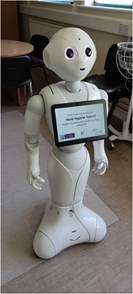
 Since Semmelweis first pioneered the practice of hand hygiene in the 19th Century, it has been recognised as the most important way to prevent healthcare-associated infection (HCAI).
Since Semmelweis first pioneered the practice of hand hygiene in the 19th Century, it has been recognised as the most important way to prevent healthcare-associated infection (HCAI).
However, still today, ensuring healthcare providers perform hand hygiene well and at the right time is challenging. Traditional interventions, often deployed as multimodal packages, have included performance feedback, education, cues (e.g., signs or scent) and placing alcohol-based hand rubs close to the point of use. At best, these interventions may slightly improve hand hygiene adherence. New interventions are needed and should begin with evaluations for feasibility prior to deployment in settings where patients are most vulnerable to HCAI.
In our study, a state-of-the art humanoid robot, ‘DAVE’ (Droid Audio Video Educator), was introduced as a reminder intervention to improve hand hygiene adherence in a hospital setting.
DAVE is a four-foot, semi-humanoid robot developed by Softbank Robotics. It is equipped with inbuilt touch and infrared sensors, a microphone, two-dimensional and three-dimensional cameras, and sonars capable of autonomous navigation, speech recognition, and perception modules to recognise and interact with the person speaking to him. The robot supports an open-source platform and is fully programmable.
We developed our own version of the application embedded in DAVE so that upon detecting a person in its field of view, it would initiate a gesture-based interaction. This interaction starts as a brief conversation by asking, “Hello, would you like to clean your hands using the sanitiser or sink?” The text from this audio prompt also displays on DAVE’s chest-mounted tablet. Upon receiving feedback from the person, it will play a short video demonstrating the World Health Organisation- recommended handwashing technique and remind the viewer how important it is to clean their hands.
DAVE is an immediate attention grabber for patients, staff and visitors – particularly young children. But does the robot have an impact on people’s hand-washing behaviour?
We conducted an audit of hand hygiene adherence in a tertiary centre at the main hospital and diabetes day centre entrances, which are used by patients, staff and visitors. This audit was performed with and without DAVE present at the entrances. When detecting a person in its field, DAVE engaged them socially and, having their attention, encouraged them to perform hand hygiene using the alcohol-based hand rub on a nearby trolley.
The baseline use of alcohol-based hand rub was low, which in itself highlights the need for improvement, particularly given the ongoing added risk of COVID-19. But with DAVE present and at work, hand hygiene adherence improved by 29% compared with the baseline audit.
For the study we recently published in Infection Prevention in Practice, only 5% of the potential technology supported by DAVE was utilised.
In practice, DAVE could be programmed to log data on hand hygiene adherence autonomously and perform audits independently, negating the need for external observers. Additionally, with the provision of artificial intelligence, DAVE could potentially be programmed to recognise individuals and create person-specific records for further evaluation.
This could have a role not only in relation to hand hygiene, but for other institutional infection prevention and control (IPC) challenges such as adherence with face mask recommendations while in the hospital environment. However, as can be the case when advanced digital technologies are introduced in environments where they have not previously been utilised, the ethical, data protection, and employee rights implications of using DAVE in these ways would need to be explored at an organisational level prior to such implementation.
In summary, DAVE, a human-like robot, was evaluated for feasibility in a hospital setting and showed promise. Just as Semmelweis’ pioneering practice of hand washing eventually proved to be revolutionary, DAVE may be just one small part of a wider digital revolution in IPC in hospital settings.
To find out more about DAVE, you can download and read the open access the short report in Infection Prevention in Practice for free here.
Hemendra Worlikar is a graduate of the Masters of Science in Biomedical Engineering programme at the National University of Ireland Galway (NUIG). He is now a research engineer with the Health Innovation Via Engineering Laboratory and School of Medicine, at NUIG.
James O’Connell is a trainee in public health medicine in the Department of Public Health, Health Service Executive West, Ireland. Prior to this, he worked with the Health Innovation Via Engineering Laboratory and School of Medicine, at NUIG.
Derek O’Keeffe is a consultant physician and professor of medical device technology at University Hospital Galway and NUI Galway, respectively. He is the director of the HIVE Lab and, as a physicianeer, has a research interest in developing digital health technology to find solutions for clinical problems.
Worlikar H, Vadhiraj VV, Murray A, O’Connell J, Connolly C, Walsh JC, O’Keeffe DT, Is it feasible to use a humanoid robot to promote hand hygiene adherence in a hospital setting? Infection Prevention in Practice, 2021. https://doi.org/10.1016/j.infpip.2021.100188